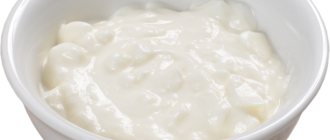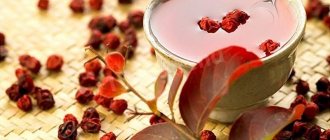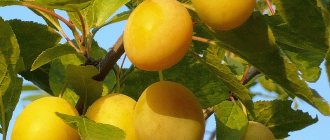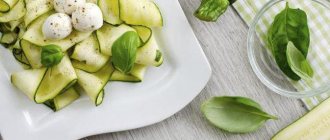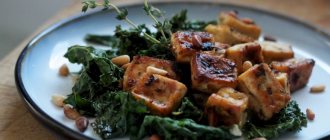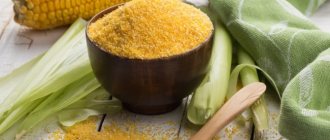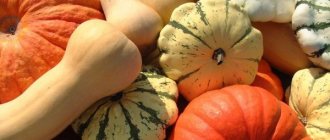Squash or plate pumpkin is a cultivated annual plant that can be found in almost every garden. The vegetable got its name from the French word pâté , which literally means “pie” in Russian.
The plant came to Europe from America in the 17th century and has not lost its popularity since then. The vegetable, which resembles a plate in shape, has become widespread in Russia.
What does this unusually shaped vegetable contain?
Squash, picked from the garden, contains a whole range of vitamins and minerals. Among them it should be noted:
- Squirrels.
- Fats.
- Carbohydrates.
- Water.
- Mono- and disaccharides.
- Cellulose.
- Organic acids.
- Pectins.
- Ash substances.
- Vitamins: A, B1, B2, B3, C, E, PP.
- Potassium.
- Calcium.
- Magnesium.
- Sodium.
- Phosphorus.
- Iron.
The product has a very low calorie content ( 18-19 kcal per 100 g ), which allows it to be used in the diet of athletes and people who dream of losing at least a few extra pounds.
Useful properties of squash
It is of great importance that the fruits of the plant contain almost all existing micro- and macroelements. They are not very popular as a source of vitamins, since they can only boast a high content of ascorbic acid, which is necessary for the successful absorption of iron. Old vegetables that have been in the garden for more than two weeks from the moment they appear are no longer suitable for human consumption, but serve as good food for pigs.
Here are the properties of squash:
- Normalization of the heart and blood vessels
. This is facilitated by the fact that squash contains a large amount of potassium. It is worth reviewing your diet if you have high blood pressure, a predisposition to heart attack, thrombosis, coronary artery disease, varicose veins and atherosclerosis. These fruits are recommended for dietary nutrition.
Read also: What are soddy-podzolic soils: properties, characteristics, structure
Cleansing the body
. These vegetables are known as wonderful antioxidants, due to their high percentage of vitamin C. They restore order in the liver, intestines, blood vessels and blood, removing all unnecessary debris from them.
Alkalinization of the body
. Raw and pickled fruits, without salt, help especially well here. To make the effect of their use even better, you should additionally drink at least 1.5 liters of water per day.
Weight loss
. This can be achieved by the low calorie content of the product, which is at the same time quite nutritious and satisfies the stomach quite quickly. After consuming it, your appetite is satisfied for at least several hours!
Eye protection
. Orange fruits are a rich source of lutein, a deficiency of which causes the vision in the eyes to become less clear. They help prevent the development of astigmatism and asthenopia. This is especially true for those who like to sit at the computer longer.
Slowing down the aging process
. Squash has this opportunity due to the large amount of ascorbic acid and potassium, which are directly responsible for these processes.
Improvement of psycho-emotional state
. It is achieved as a result of regular consumption of fruit seeds, along with which vitamins C, B1 and B2 enter the body.
What benefits do squash dishes provide to the body?
Squash, which has firmly taken its place in the European cookbook, is not only a light dietary product. This vegetable, which in its raw form does not have a pronounced taste or smell, can have an invaluable effect on the human body.
In particular, it has the following actions:
- Reduces the risk of cancer.
- Prevents the development of atherosclerosis, ischemia, arrhythmia, stroke, heart attack.
- Promotes the process of losing weight.
- Eliminates inflammatory processes in the gastrointestinal tract.
- Neutralizes toxicoses of various etiologies.
- Lowers blood pressure.
- Normalizes the process of formation of new blood cells.
- Eliminates chronic constipation.
- Stabilizes the functioning of the gastrointestinal tract.
- Provokes the outflow of bile and normalizes liver function.
- Improves blood composition and strengthens the walls of blood vessels.
- Prevents nervous system disorders (insomnia, depression).
- Regulates the functions of the endocrine system.
- Stabilizes the water-salt balance, eliminates swelling.
- Enriches the intestinal microflora, eliminates dysbiosis.
- Facilitates kidney function.
- Eliminates migraine.
Like all plants from the pumpkin family, squash is included in the therapeutic diet for kidney and liver failure. And the presence of potassium and magnesium in it allows it to be used in the treatment of cardiovascular diseases.
The benefits and harms of squash are facts proven by science. Useful properties of squash for humans
Squash or plate pumpkin is a cultivated annual plant that can be found in almost every garden.
The vegetable got its name from the French word pâté, which literally means “pie” in Russian. The plant came to Europe from America in the 17th century and has not lost its popularity since then. The vegetable, which resembles a plate in shape, has become widespread in Russia.
Squash, picked from the garden, contains a whole range of vitamins and minerals. Among them it should be noted:
- Squirrels.
- Fats.
- Carbohydrates.
- Water.
- Mono- and disaccharides.
- Cellulose.
- Organic acids.
- Pectins.
- Ash substances.
- Vitamins: A, B1, B2, B3, C, E, PP.
- Potassium.
- Calcium.
- Magnesium.
- Sodium.
- Phosphorus.
- Iron.
The product has a very low calorie content (18-19 Kcal per 100 g), which allows it to be used in the diet of athletes and people who dream of losing at least a few extra pounds.
Squash, which has firmly taken its place in the European cookbook, is not only a light dietary product. This vegetable, which in its raw form does not have a pronounced taste or smell, can have an invaluable effect on the human body.
In particular, it has the following actions:
- Reduces the risk of cancer.
- Prevents the development of atherosclerosis, ischemia, arrhythmia, stroke, heart attack.
- Promotes the process of losing weight.
- Eliminates inflammatory processes in the gastrointestinal tract.
- Neutralizes toxicoses of various etiologies.
- Lowers blood pressure.
- Normalizes the process of formation of new blood cells.
- Eliminates chronic constipation.
- Stabilizes the functioning of the gastrointestinal tract.
- Provokes the outflow of bile and normalizes liver function.
- Improves blood composition and strengthens the walls of blood vessels.
- Prevents nervous system disorders (insomnia, depression).
- Regulates the functions of the endocrine system.
- Stabilizes the water-salt balance, eliminates swelling.
- Enriches the intestinal microflora, eliminates dysbiosis.
- Facilitates kidney function.
- Eliminates migraine.
Like all plants from the pumpkin family, squash is included in the therapeutic diet for kidney and liver failure. And the presence of potassium and magnesium in it allows it to be used in the treatment of cardiovascular diseases.
The product has become widespread and deservedly popular primarily due to its availability. Not the least role in the use of the product is played by its nutritional composition.
Pumpkin is included in many dishes. It is used in hot and cold dishes: sautés, salads, rolls, pancakes. The vegetable can be pickled, stuffed, boiled, steamed, fried and baked.
In order to make your favorite product available at any time of the year, it is prepared for the winter using the method of pickling and salting (soaking).
The very shape of the squash makes it very convenient to stuff. You can choose the filling for the minced meat according to your taste. It can be minced meat with rice, pieces of meat with fried onions.
Fans of vegetarian dishes can replace the minced meat with a mushroom filling with fried onions. Stewed vegetables (onions, carrots, cabbage, tomatoes, eggplants) can be a good alternative to meat.
- Medium sized squash – 6 pcs.
- Minced meat – 0.5 kg.
- Ghee butter – 0.1 kg.
- Onions – 3 pcs.
- Hard cheese – 0.3 kg.
- Salt, pepper, spices - to taste.
- Fresh cilantro (or any other greens) - 1 medium bunch.
- Sour cream or cream – 0.25 kg.
At the beginning of the cooking process, you should sort out the greens and peel the onions. Then wash the meat and vegetables thoroughly. When everything is ready, you can start preparing the squash. To do this, cut off the “cap” in the place where the vegetable’s tail is located.
Then, using an ordinary tablespoon, you need to select the pulp from the vegetable so that you get something like a “pot”, which will subsequently be filled with minced meat. To prepare the filling, take a frying pan and heat 50 g of oil in it. Place minced meat and finely chopped onion there. Add salt and pepper to taste.
Lightly fried minced meat should be placed in “molds” prepared from squash and covered with their own “lids”. Place the stuffed vegetables on a baking sheet and pour over the remaining melted butter.
The baking sheet with filled vegetables is sent to the oven, preheated to 180-200 o for 25 minutes. Then you need to remove it from the oven and sprinkle the vegetables with cheese grated on a coarse grater.
A non-toxic and useful product in many respects, it has some contraindications. To avoid negative emotions and negative consequences, you should follow some simple rules.
Squash can cause undesirable effects on the body for the following reasons:
- Gastrointestinal dysfunction (diarrhea, intestinal obstruction).
- Vegetative-vascular dystonia, hypotension.
- Predisposition of the gallbladder and kidneys to the formation of sand and stones.
In principle, this product does not provoke an allergic reaction. However, in pickled form, it should be included with caution in the diet of people suffering from pancreatic diseases. The content of vinegar (acetic acid) in the marinade can provoke an exacerbation of the disease.
An excellent dietary product is not capable of causing irreparable harm to human health. Given the existing contraindications, negative consequences can be easily avoided. All the pros and cons should be resolved at an appointment with a nutritionist.
Patisson is a small pumpkin that is shaped like a pie. Young fruits are considered real delicacies. They have tender, slightly sweetish flesh with a slight mushroom flavor. Vegetables are included in the list of dietary products, because per 100 g of squash there are only 19 kcal. But the main reason why European countries love dishes made from miniature pumpkins is the huge amount of vitamins and fiber.
Young vegetables are added to stews and turned into dietary soups. But baked fruits are the healthiest. Why? Squash is the record holder among zucchini and pumpkins for ascorbic acid content. The body needs vitamin C no less than water, because it belongs to the group of antioxidants.
The substances have anti-cancer properties. They absorb free radicals, reducing the likelihood of malignant tumors in the spinal cord and brain. Antioxidants slow down the aging of muscles and bone tissue. Protects against early wrinkles and regenerates damaged skin.
Dishes made from squash are useful in the autumn-winter period. 100 g of pulp, which has undergone minimal heat treatment, contains about 20–25 mg of ascorbic acid. That is, approximately a quarter of the required daily requirement.
Read more: Cranberry benefits and harm to the health of the body
Pumpkins baked with butter stimulate the production of antibodies. Squash supports the immune system and helps the body resist viruses that cause colds and flu.
The fruits take care of the joints. Ascorbic acid is the basis for the production of collagen. The substance increases the elasticity of cartilage tissue and muscles, preventing arthrosis. Collagen is also necessary for the skeletal system. Without it, the skeleton will become too fragile. Any mechanical damage can cause a serious fracture.
Squash should be included in the diet of people prone to depression. The adrenal glands use vitamin C to produce many hormones:
- adrenaline;
- dopamine;
- serotonin.
The body begins to release adrenaline when faced with stress. The hormone helps the body survive an emergency situation with minimal health consequences. Dopamine and serotonin are the sources of happiness and high spirits. They are responsible for the state of euphoria and reduce the likelihood of depression.
Squash is good for the cardiovascular system. One of the main causes of early heart attacks is atherosclerosis. Abuse of processed foods and animal fats leads to the deposition of bad cholesterol on the walls of blood vessels. Arteries and capillaries become thinner and lose their elasticity. Problems with blood circulation and blood pressure arise. Bad cholesterol weakens the heart muscle. Leads to arrhythmias and tachycardias.
How can squash prevent a heart attack? All thanks to vitamin C. The liver uses ascorbic acid to neutralize and eliminate bad cholesterol. In addition, small pumpkins are responsible for the production of collagen. And elastic fibers tone blood vessels, increasing their strength and clearing them of fatty deposits.
Ascorbic acid is needed by the body to absorb iron. Vitamin C increases red blood cell levels and prevents anemia. By the way, squash contains a small amount of iron. But there is too little of it, so it is recommended to combine pumpkins with liver, pomegranates or beets.
Fruits are best baked in foil. It retains a lot of vitamin C. But squash should be eaten immediately after cooking. Vegetables that have undergone repeated heat treatment do not contain ascorbic acid.
Useful minerals
Miniature pumpkins contain not only vitamin C, but also potassium and magnesium. Minerals are good for the heart and nervous system. Substances are responsible for the transmission of impulses and muscle function.
Dishes made from squash are recommended for frequent cramps. Involuntary muscle contractions are observed in several categories of people:
- athletes;
- pensioners;
- fans of diets and fasting;
- hypertensive patients.
Exercise, medications for high blood pressure and heart disease wash potassium out of the body. The level of the mineral decreases due to unbalanced nutrition and age-related changes.
Elderly people and fitness enthusiasts should consume squash at least 3-4 times a week. Baked pumpkins will protect muscle and cartilage tissue, and also prevent the formation of ulcers on the mucous membranes.
Potassium contained in fruits normalizes water-salt balance. The mineral will not allow sodium to be deposited in soft tissues and retain excess water in the body. Squash helps with edema, heart failure, and problems with urination. They protect against chronic fatigue and insomnia.
Vegetables have a positive effect on mental activity. Pumpkins are involved in cleansing the body of toxins and also reduce allergy symptoms. In addition, squash is a source of energy and the reason for increased endurance.
Cellulose
Pumpkins, like other vegetables, are rich in dietary fiber. These are coarse particles, without which the intestines cannot function normally. But normal digestion is necessary for excellent health, strong immunity and a beautiful figure.
- Squash is a tasty and nutritious vegetable with low energy value. Dishes prepared from them can become the basis of dietary nutrition for people who decide to lose excess weight.
- Pumpkin contains vitamin E, potassium, ascorbic acid and other substances that can slow down the aging process of the body.
- Squash are rich sources of substances that strengthen the immune system.
- The antioxidant compounds this vegetable is rich in protect cells from the negative effects of free radicals. Regular consumption of it reduces the risk of developing tumors.
- Group B vitamins and other nutrients contained in squash pulp heal the nervous system and prevent the development of somnological disorders. People who consume it daily are better able to cope with nervous shock and stress and rarely experience mood swings or manifestations of neuroses and depression.
- The juice of this vegetable contains a whole range of substances that promote the production of hemoglobin and normalize the functioning of the hematopoietic system. The drink is useful for people suffering from anemia.
- Potassium and magnesium, present in the pulp and seeds of pumpkin, regulate the heartbeat, strengthen the heart muscle, increase the strength and elasticity of the walls of blood vessels, maintain blood pressure within normal limits, and prevent the formation of blood clots. Dishes made from this vegetable are useful for people prone to strokes and heart attacks, suffering from hypertension, cardiac ischemia, varicose veins, thrombosis, and atherosclerosis.
- Patisson is a rich source of fiber. The vegetable helps remove toxins, excess fluid and bad cholesterol from the body.
- Dishes made from pumpkin help speed up your metabolism.
- Squash juice has choleretic and diuretic properties. Therefore, traditional healers recommend this drink to people suffering from diseases of the urinary system and biliary tract.
- Pumpkin seeds crushed into pulp have anthelmintic properties. For parasitic infestations, you must eat at least 3 tbsp. spoons of this remedy per day.
- Patisson is a mild laxative. A drink made from the juice of this vegetable and honey helps cope with long-term constipation, flatulence, and intestinal colic.
- Pumpkin seeds help normalize the functioning of the endocrine system. Dried vegetable raw materials are ground in a coffee grinder and eaten 20 minutes before each meal. A single dose of a therapeutic and prophylactic agent is 2 tbsp. spoons.
- In folk medicine, squash juice is used to treat long-healing wounds.
- The juice obtained from this vegetable helps alleviate the condition of people suffering from intestinal dysbiosis.
- The beneficial compounds present in squash help normalize the level of oxalic acid in the body and stimulate protein metabolism. Therefore, this product is very often included in the diet menu for people suffering from gout.
- Pumpkin contains lutein and other compounds that have a positive effect on the condition of the visual apparatus, reducing the risk of developing asthenopia (increased visual fatigue) and astigmatism (decreased image clarity due to a violation of the shape of the eye, its cornea or lens). Dishes made from this vegetable are very useful for people who have to spend a lot of time in front of a computer monitor.
- The squash pulp is used to prepare a cosmetic mask that rejuvenates, softens and brightens the skin. Grate the vegetable and apply the resulting pulp to problem areas for 20 minutes.
Read more: Ascorbic acid with glucose: benefits and harms
- It is forbidden to eat squash that has been growing in the garden for more than 2 weeks. The pulp of such fruits accumulates caustic compounds that can cause severe intoxication of the body.
- Pumpkin is a potential allergen. People with food allergies should be careful when including it in their diet.
- Squash is contraindicated for persons who have previously been diagnosed with disorders of the pancreas, diabetes mellitus, gastric or duodenal ulcers, or hypotension.
- Dishes made from plate pumpkin are not recommended for nursing mothers, women during pregnancy and children under 10 years of age.
- boron – 19.668 mcg;
- cobalt – 0.944 mcg;
- nickel – 3.096 mcg;
- vanadium – 6.314 mcg;
- zinc – 289.638 mcg;
- manganese – 189.704 mcg;
- iron – 0.344 mg;
- selenium – 0.198 mcg;
- copper – 74.117 mcg;
- rubidium – 5.573 mcg;
- iodine – 0.274 mcg.
The use of squash in cooking
The product has become widespread and deservedly popular primarily due to its accessibility . Not the least role in the use of the product is played by its nutritional composition.
Pumpkin is included in many dishes. It is used in hot and cold dishes: sautés, salads, rolls, pancakes. The vegetable can be pickled, stuffed, boiled, steamed, fried and baked.
In order for your favorite product to be available at any time of the year, it is prepared for the winter using the method of pickling and salting ( soaking ).
The very shape of the squash makes it very convenient to stuff . You can choose the filling for the minced meat according to your taste. It can be minced meat with rice, pieces of meat with fried onions.
Fans of vegetarian dishes can replace the minced meat with a mushroom filling with fried onions. Stewed vegetables (onions, carrots, cabbage, tomatoes, eggplants) can be a good alternative to meat.
Stuffed squash recipe
Ingredients:
- Medium sized squash – 6 pcs.
- Minced meat – 0.5 kg.
- Ghee butter – 0.1 kg.
- Onions – 3 pcs.
- Hard cheese – 0.3 kg.
- Salt, pepper, spices - to taste.
- Fresh cilantro (or any other greens) - 1 medium bunch.
- Sour cream or cream – 0.25 kg.
At the beginning of the cooking process, you should sort out the greens and peel the onions. Then wash the meat and vegetables thoroughly. When everything is ready, you can start preparing the squash. To do this, cut off the “cap” in the place where the vegetable’s tail is located.
Then, using an ordinary tablespoon, you need to select the pulp from the vegetable so that you get something like a “pot”, which will subsequently be filled with minced meat. To prepare the filling, take a frying pan and heat 50 g of oil . Place minced meat and finely chopped onion there. Add salt and pepper to taste.
Lightly fried minced meat should be placed in “molds” prepared from squash and covered with their own “lids”. Place the stuffed vegetables on a baking sheet and pour over the remaining melted butter.
The baking sheet with filled vegetables is sent to the oven, preheated to 180-200o for 25 minutes . Then you need to remove it from the oven and sprinkle the vegetables with cheese grated on a coarse grater.
The vegetables go back into the oven for another 5-10 minutes . Ready squash can be sprinkled with finely chopped herbs and served with sour cream or cream. Those who like a spicy taste can add chopped garlic to the minced meat. Or serve the finished dish with garlic sauce.
Calorie content of squash
100 g of raw squash contains 18.748 kcal. The energy value of a medium-sized fruit (250 g) is 46.87 kcal. A glass of pumpkin pulp contains 28.122 kcal, a tablespoon contains 3.749 kcal, and a teaspoon contains 1.312 kcal.
Calorie content of 100 g of fried squash - 81.709 kcal, stewed - 18.904 kcal, pickled - 17.993 kcal, baked - 21.012 kcal. The energy value of a 100-gram serving of squash caviar is 81.683 kcal.
Read also: Collecting and preparing aspen milk mushrooms
Possible harm and contraindications
A non-toxic and useful product in many respects, it has some contraindications. To avoid negative emotions and negative consequences, you should follow some simple rules.
Squash can cause undesirable effects on the body for the following reasons:
- Gastrointestinal dysfunction (diarrhea, intestinal obstruction).
- Vegetative-vascular dystonia, hypotension.
- Predisposition of the gallbladder and kidneys to the formation of sand and stones.
In principle, this product does not provoke an allergic reaction. However, in pickled form, it should be included with caution in the diet of people suffering from pancreatic diseases. The content of vinegar (acetic acid) in the marinade can provoke an exacerbation of the disease.
